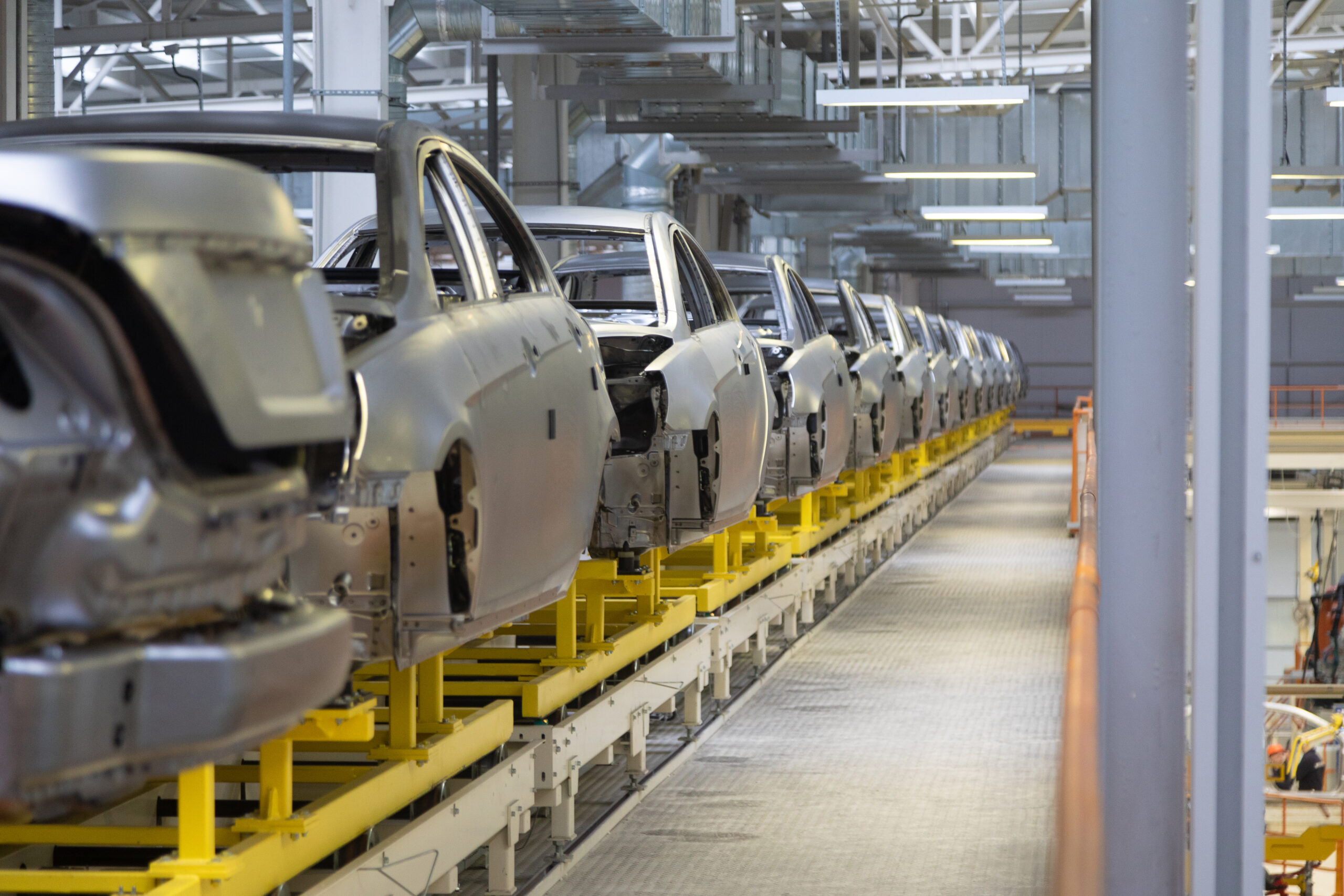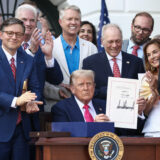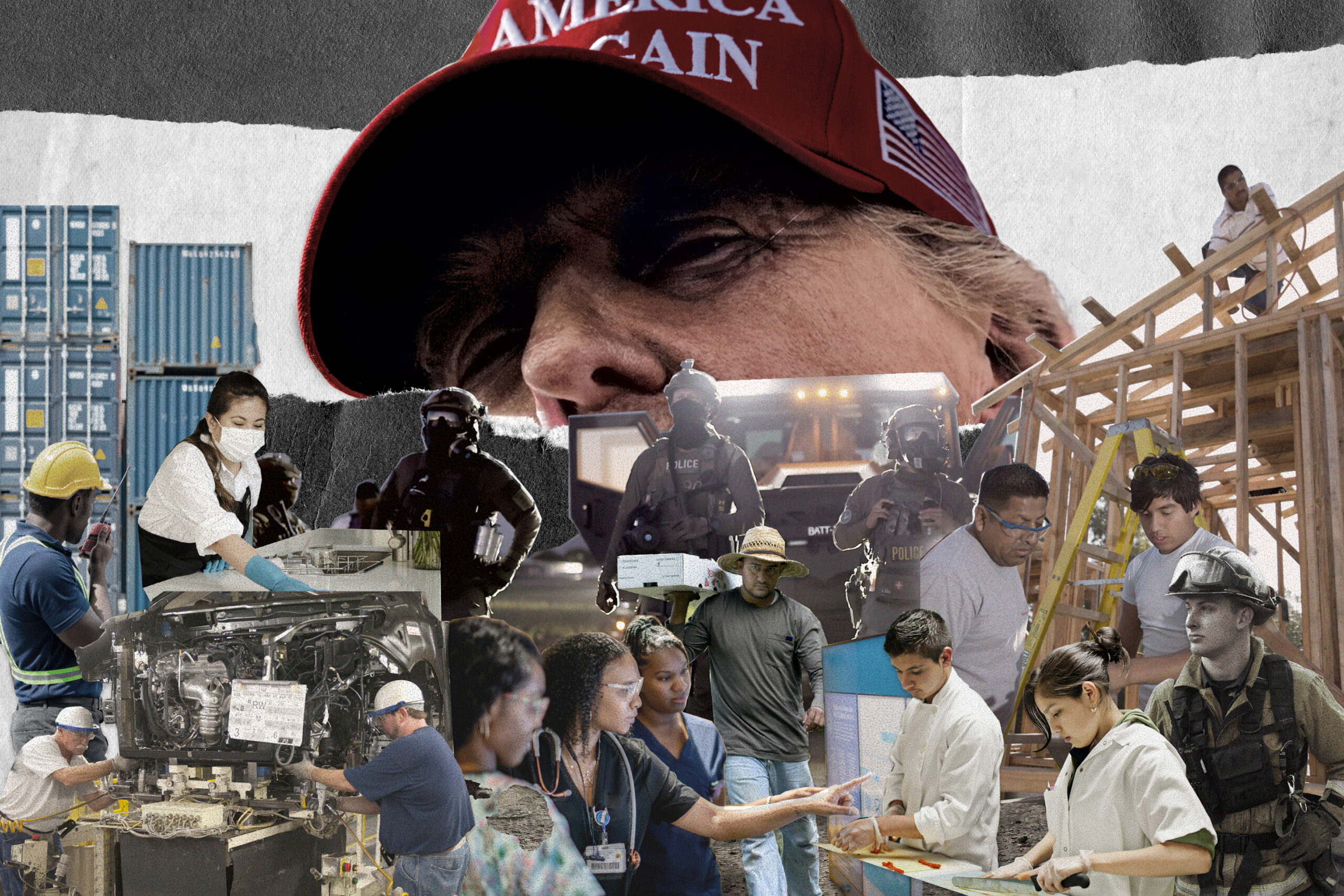Many American businesses are bracing for higher costs after President Donald Trump levied wide-ranging tariffs this spring, a move that economists have largely panned. But for workers in southeastern Michigan, the heart of the U.S. automotive industry, the story is a little more complicated. Here, manufacturing is “our lifeblood,” according to Sean Crawford, a skilled trades apprentice at General Motors’ Warren Tech Center in suburban Detroit.
A Trump critic, Crawford is mostly skeptical that tariffs will lead to more or better jobs. But Crawford’s co-workers have generally welcomed tariffs on foreign auto manufacturers, he said. As a third-generation autoworker, he understands the appeal. “They’re just happy something is being done,” he said.
Crawford grew up in Flint, Michigan, where he witnessed the loss of thousands of GM jobs decimate the town’s economy. For generations, manufacturing jobs helped people in the region build stable lives — purchase homes, raise families and end their careers with secure retirement.
Trump tapped into that manufacturing mythos when he vowed to make the country “a manufacturing nation once again” in his inauguration speech. He had repeated this message often on the campaign trail, promising to “create millions and millions of jobs, massively raise wages for American workers and make the United States into a manufacturing powerhouse like it used to be many years ago.”
Yet rather than the promised manufacturing revival, the first eight months of Trump’s second term have brought uncertainty and upheaval. Widespread tariffs stalled hiring and rollbacks of clean energy policies have stymied investment and disrupted the fragile momentum that had been building under President Joe Biden, whose legislative agenda had spurred investment in manufacturing.
The fledgling growth of domestic manufacturing that had created more than 610,000 manufacturing jobs during the Biden administration and laid the groundwork for many more has “basically collapsed,” said Todd Tucker, director of industrial policy and trade at the Roosevelt Institute, a Washington-based, left-leaning think tank.
In fact, Trump was so dissatisfied with the weak July jobs report — which showed that the U.S. manufacturing sector had lost 37,000 jobs over three straight months — that he fired the director of the Bureau of Labor Statistics in early August, alleging on his social media platform Truth Social that the less-than-stellar job numbers were “RIGGED in order to make the Republicans, and ME, look bad.”
* * *
Since the president first announced his sweeping tariffs, the country’s trade policy has been marked by chaos and volatility. The tariffs have been wielded for sharply different purposes, with some intended to protect domestic markets and others aimed at punishing foreign countries for actions Trump doesn’t like. That shifting rationale has deepened the sense of uncertainty, as have the constantly changing tariff rates. In addition, countries around the world have responded to the new trade regime with their own retaliatory tariffs.
“It’s almost impossible to keep up with the new deals, the new tariffs, the tariff cuts and the tariff hikes,” said Tucker. The instability is “the opposite of what companies need to be able to make long-term investments.”
That uncertainty has had a chilling effect on manufacturing. Many companies are pulling back from hiring simply because, amid the impulsive and erratic policymaking of the Trump administration, they don’t know what will happen next.
According to a second-quarter survey from the National Association of Manufacturers, just 55.4% of manufacturers are optimistic about the future of their companies — a 15-percentage-point drop since the first quarter and the lowest rating since the early days of the pandemic. Indeed, 89% of manufacturers surveyed said that operational costs have increased due to tariffs. While economists have criticized the broad reach of Trump’s tariffs, Tucker said that “select, strategic and targeted tariffs” could help some American industries.
Crawford’s union, the United Auto Workers, hopes that the 25% tariff on most foreign automakers will lead to a resurgence in domestic manufacturing and more stable jobs for autoworkers. (Japan, whose automakers hold a significant share of the U.S. market, recently negotiated its tariff rate down to 15% in a deal with the Trump administration.)
“[W]e do not support reckless chaotic tariffs on all countries,” UAW President Shawn Fain wrote in an April op-ed for Jacobin. But auto tariffs, he wrote, are “a first step in ending the free-trade disaster,” adding that “the automakers, the auto market, and corporate America can afford it.”
Crawford is not so sure tariffs are a winning strategy, even tariffs on foreign car makers. “With the tariffs swinging as wildly as they are … I feel like a lot of [car] companies aren’t on firm footing,” he said. He said it’s possible that his job and workplace could benefit, adding that even one additional shift at a plant could create jobs that would be a boon to the local economy. But he doubts that tariffs will inspire companies to break ground on new facilities. Instead, he reasons that if companies pass off tariff costs onto consumers, demand will decline, and layoffs could follow.
Crawford’s concerns about layoffs have already been borne out. GM’s profit fell by more than $1 billion in the second quarter of the year compared to the same period in 2024, a decline executives attributed in part to tariffs. The company temporarily laid off 200 workers at a factory in Detroit suburb Hamtramck in April (though GM representatives blamed “market dynamics,” not tariffs.) That same month, Stellantis laid off 900 workers following dismal quarterly earnings, and Volvo cut more than 1,000 workers at its Mack Truck plants in Pennsylvania, Maryland and Virginia.
At the same time, tariff pressures led GM to announce in April that the company would increase production at a plant in Fort Wayne, Indiana, and hire 225-250 temporary workers. But temporary workers earn lower pay than other hourly workers and also receive fewer benefits. Temporary status may not even be temporary; Crawford said he’s known temporary workers that have held “temporary” positions for as many as seven years. And that’s not including the workers hired by third-party agencies to do auto production work for companies like GM.
“Yeah, American manufacturing, rah rah rah,” Crawford said sarcastically. “But are those actually going to be good jobs? Are they going to be unionized jobs? Are they going to be family and community supporting jobs?”
If not, he thinks the rhetoric is just “emotionally exploiting” workers who want the secure and stable work manufacturing once promised.
* * *
While it remains to be seen how exactly auto manufacturing will be impacted by tariffs, clean energy manufacturing — which was growing rapidly under the Biden administration — has been hard hit by Trump’s industrial policy. Since the start of 2025, more than $18 billion in clean energy manufacturing projects have been cancelled, according to data from environmental business coalition E2. Those cancellations translate into thousands of jobs that will never materialize.
“We were on the cusp of an economic revolution the likes we haven’t seen in generations,” said Bob Keefe, executive director of E2. “Unfortunately, that is now at risk,” he said.
As just one example, more than 1,000 jobs were intended for union sheet metalworkers at a Cleveland-Cliffs Inc. site near Dayton, Ohio, that was set to transition from fossil fuels to hydrogen. Instead, the facility will continue to produce “beautiful coal,” with a goal to “operate fully under AI,” CEO Lourenco Goncalves said in a July earnings call. According to Steel Industry News, the AI operation is meant to increase efficiency for the company by 15%-20%.
“Automation is the name of the game” in many facilities, Babak Hafezi, adjunct professor at American University’s Kogod School of Business and CEO of international consulting firm Hafezi Capital, said in an email. He predicts companies will choose between two strategies if Trump’s trade policy stands: Use exclusively domestic materials alongside automation — in which cases workers are unlikely to benefit — or move production to the cheapest country possible. Either way, workers — and communities that rely on manufacturing — will lose, according to Hafezi.
Crawford believes a stronger labor movement is ultimately what will lead to a resurgence of American manufacturing jobs. It’s hard for workers to bargain for jobs when unions “don’t really have the same dominance in the auto sector like we used to,” he said. He is unsurprised that some manufacturing workers have welcomed tariffs, even if they may mean higher prices and fewer opportunities for other workers.
“People want jobs,” Crawford said. “That’s understandable.”
Copyright 2025 Capital & Main


 Latest NewsDecember 8, 2025
Latest NewsDecember 8, 2025
 Striking BackDecember 4, 2025
Striking BackDecember 4, 2025
 The SlickDecember 2, 2025
The SlickDecember 2, 2025
 Dirty MoneyDecember 3, 2025
Dirty MoneyDecember 3, 2025
 Child FarmworkersDecember 5, 2025
Child FarmworkersDecember 5, 2025
 Column - State of InequalityDecember 4, 2025
Column - State of InequalityDecember 4, 2025
 Latest NewsDecember 10, 2025
Latest NewsDecember 10, 2025
 StrandedDecember 9, 2025
StrandedDecember 9, 2025

